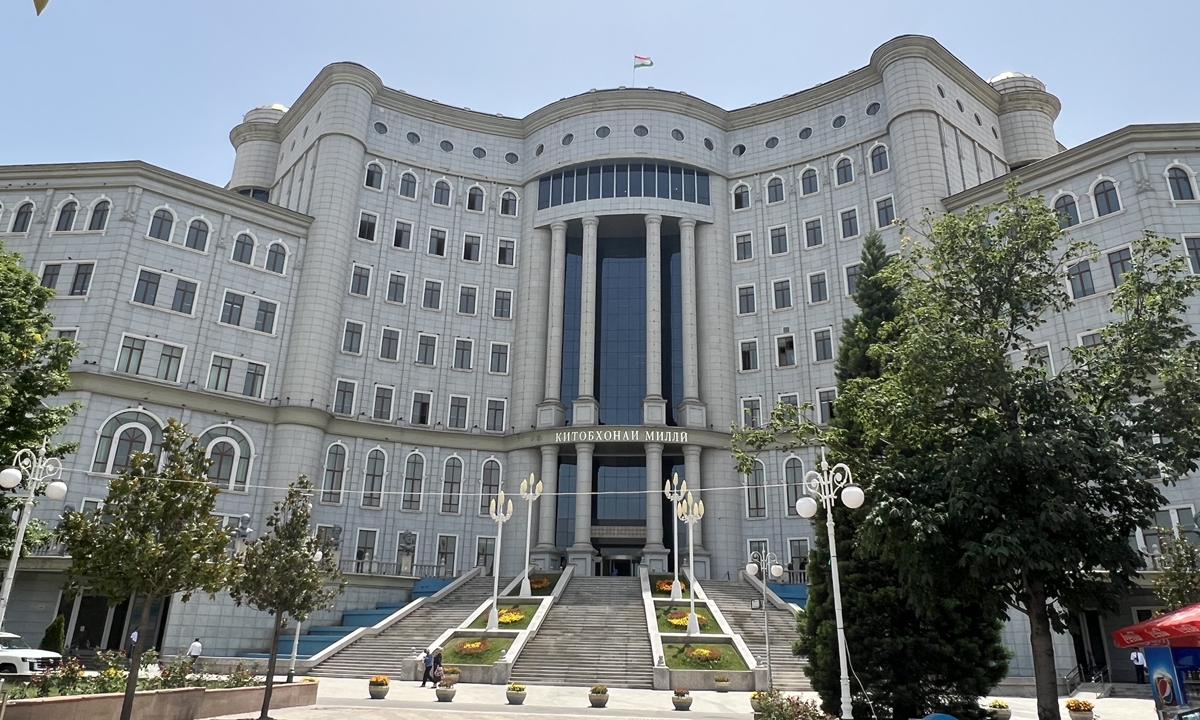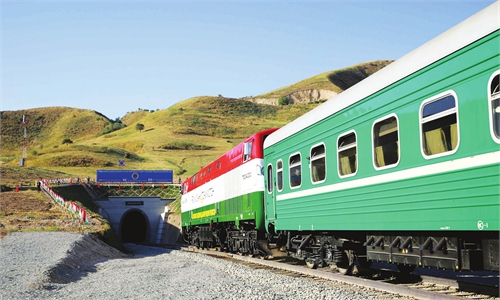Central Asia transformed from landlocked region to Eurasia transport hub under BRI, SCO framework

The Tajik National Library in Dushanbe, capital of Tajikistan Photo: Li Xuanmin/GT
Regional development has been a priority under the Shanghai Cooperation Organisation (SCO) framework and the China-proposed Belt and Road Initiative (BRI). Central Asia has been transforming from a "landlocked" region to a transportation hub in Eurasia, witnessing great improvement in internal connectivity while also integrating itself more seamlessly into the global economic and logistics chain, Chinese company representatives and scholars from Central Asia said.
The comments were made during Chinese President Xi Jinping's state visits to Kazakhstan and Tajikistan, which kicked off on Tuesday and last until Saturday, during which Xi will also attend the 24th Meeting of the Council of Heads of State of the SCO to be held in Astana.
Observers and industry insiders also expect more infrastructure projects to be discussed during the visit, in particular with regards to new progress on the China-Kyrgyzstan-Uzbekistan railway project and the joint development of the Trans-Caspian International Transport Route (TITR), also known as the "Middle Corridor," which would all give a further boost to regional connectivity and facilitate China's westward opening-up.
In Dushanbe, the capital of Tajikistan, the Tajik National Library, a nine-story landmark building, stands at the city's business center. The library, appearing on the country's 200 Somoni bank note, is being built by CSCEC Xinjiang Construction and Engineering Group.
The library, the largest of its kind in Central Asia, offers a vivid demonstration of how Chinese companies have been leveraging their advantages in technology know-how and rich experiences to foster infrastructure development across Central Asia.
"Compare the geographic maps of Central Asia prior to the BRI with up-to-date maps of the region: new railroads, highways, bridges, port and cargo terminals, gas and oil pipelines, electric power stations, high-tech agricultural farms, which all point to dramatic transformation and huge leaps in the 21st century," former SCO secretary-general Bolat Nurgaliyev told the Global Times in an exclusive interview.
"Tajikistan is a country of high mountains, with nearly 90 percent mountainous landscape, Chinese companies have helped the country build all the four main arterial traffic routes to date," Zhi Bin, deputy general manager of China Road and Bridge Corporation in Tajikistan, told the Global Times.
Zhi gave as an example the Tajikistan-Uzbekistan Highway restoration and renovation project, which was implemented in 2006. It was the SCO's largest basic infrastructure cooperation project at the time.
The project has shortened the travel time from Khujand, the second-largest city in Tajikistan, to the capital Dushanbe from between 10 and 14 hours to around seven hours. Meanwhile, most of the highway - before the project implementation - was blocked for half of the winter season due to the dual effect of high mountains and icy roads, which severely affected Tajikistan's trade with Uzbekistan, and the local residents' normal lives," Zhi said.
The Chinese company currently is also undertaking the second stage of the China-Tajikistan Highway project, a 92.3-kilometer-long road that is a key part of the overall China-Tajikistan highway networks. According to Zhi, the completion of the second stage of the highway, which is already an important passage for shipment of various commodities including BYD's new-energy vehicle between China and Tajikistan, could further drive the bilateral trade turnover to grow further.
During a state visit to Kazakhstan in September 2013, Xi proposed the Silk Road Economic Belt, an essential component of the BRI.
In Kazakhstan, the joint implementation of a number of the BRI-related connectivity projects such as the China-Kazakhstan International Logistics Base in Lianyungang, East China's Jiangsu Province, has also made the country a key link between Eurasia and the Asia-Pacific region in recent years.
Industry insiders said they expect more infrastructure projects on "external connectivity" to be launched, further promoting the China-Central Asia infrastructure cooperation to move to deeper and broader areas.
"Central Asia is still in dire need of more infrastructure development. Take Tajikistan. The country is one of the earliest countries to join the China-proposed BRI, which synergizes with the country's development strategy. So, there's a solid foundation and a great potential to be tapped in terms of infrastructure cooperation between the two economies," Wang Peng, general manager of the overseas business division under the CSCEC Xinjiang Construction and Engineering Group, told the Global Times.
In July, an intergovernmental agreement on the China-Kyrgyzstan-Uzbekistan railway project was signed in Beijing, the Xinhua News Agency reported. As a milestone connectivity project between China and SCO members under BRI, the railway begins in Kashi, Northwest China's Xinjiang Uygur Autonomous Region, and enters the territory of Uzbekistan through Kyrgyzstan.
"The transnational railway, when completed, will further cement Central Asia's role as a bridge connecting western China, as well as West and South Asia, with the European continent," Zhi explained, noting that it could also increase the number of international corridors stretching from China's Xinjiang region from one to two.
Last year, Astana and Beijing signed the Agreement on the Joint Development of TITR. According to Nurgaliyev, when the TITR is fully operational, it will be the most convenient, reliable and shortest route for cargo shipments between China and Europe through Kazakhstan.



